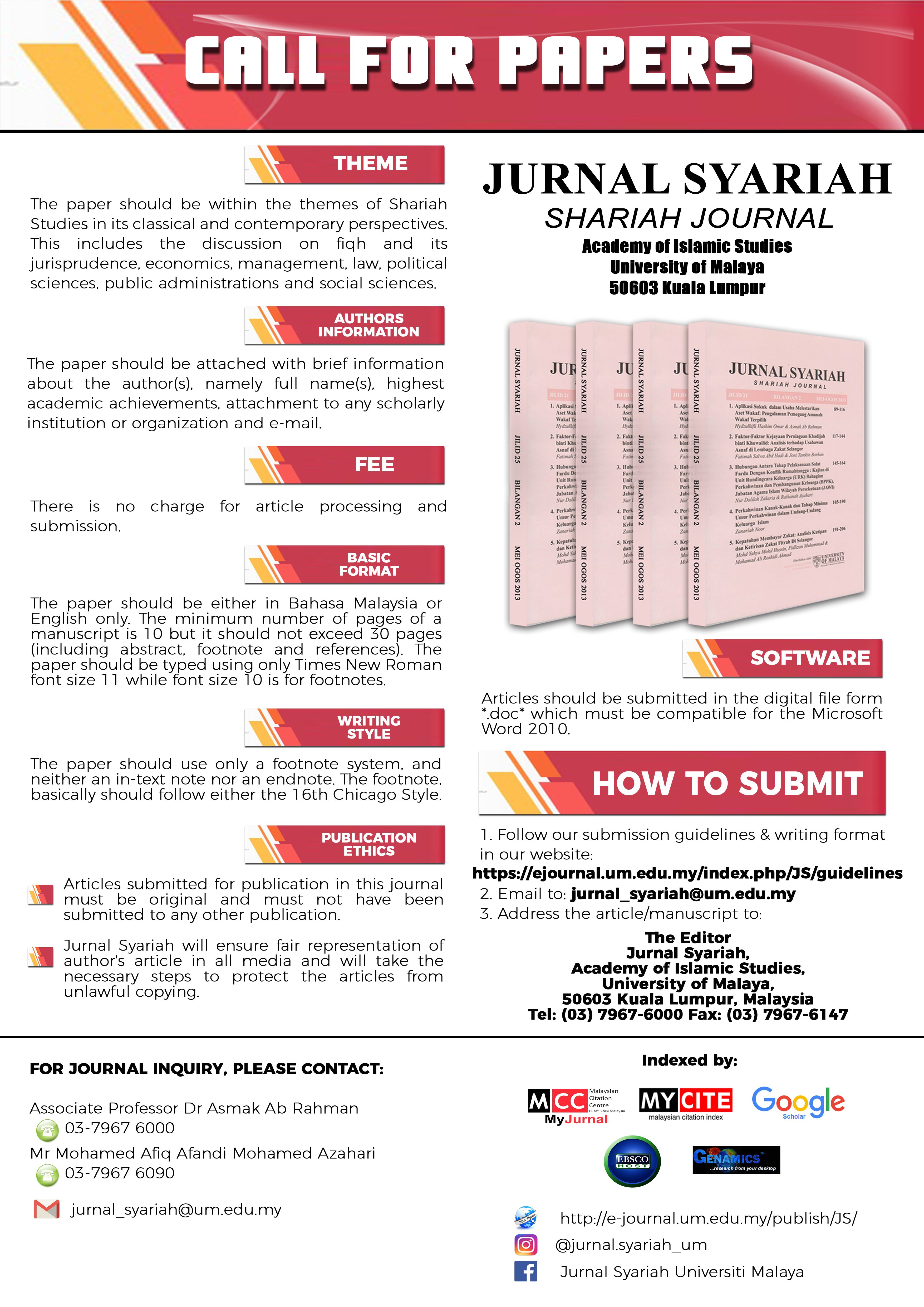LEGAL AND SOCIAL COMPLEXITIES RELATING TO PRACTICE OF ARRANGED AND FORCED MARRIAGES
DOI:
https://doi.org/10.22452/js.vol29no1.2Keywords:
forced marriage, arranged marriages, human rights, culture and gender, religion and violationAbstract
The practice of forced and/or arranged marriages are reported to be taking place globally. These types of marriages have become gender neutral and can no longer be described only as an issue relating to women. However, what is portrayed is that women normally suffer as reported cases are evidence of that. First world countries where there is a large immigrant community, frown on the practice of forced marriages and arranged marriages. This is a complex issue, because on the one hand, one’s religious, cultural diversity is attacked and on the other hand forced and arranged marriages may violate various provisions of international, regional national human rights instruments. From an international law perspective, one could argue that there is a clear violation of international law. On the other hand, and argument relating to one’s cultural and religious beliefs could also be advanced. Concepts such as culture, religion and gender are deeply embedded in most known religions and communities, therefore, the practice of forced and arranged marriages may not be perceived as violation of any law/s whether international or national. Furthermore, forced and arranged marriages are at times so interrelated that it may be difficult to draw a clear distinction between the two. How do we protect women’s rights while at the same time respecting the cultural diversity of society? This article attempts to add to the existing debate surrounding the social and legal complexities of forced and arranged marriages.
Downloads
References
Chantler K., ‘Recognition of and Intervention in Forced Marriages as a Form of Violence and Abuse,’ Sage Journals: Trauma, Violence, & Abuse, vol. 13/3 (2012): 176-183.
Chantler K., Gangoli G. & Hester M., ‘Forced Marriage in the UK: Religious, Cultural, Economic or State Violence?’ Feminist Legal Studies, vol. 17 (2009): 267-288.
Cohn H., ‘Religious Human Rights,’ 19 Dine Israel 101 (1997-1998), http://religionhumanrights.org, accessed on 19 June 2019.
Frίas S., ‘Family and Partner Violence against Women: Forced Marriage in Mexican Indigenous Communities,’ International Journal of Law, Policy and The Family, vol. 31/1 (2017): 60-78.
Gangoli G. & Chantler K., ‘Protecting Victims of Forced Marriage: Is Age a Protective Factor?’ Fem Leg Stud, vol. 17 (2009): 267-288.
Gill A.K. & Hamed T., ‘Muslim Women and Forced Marriages in the UK,’ Journal of Muslim Minority Affairs, vol. 36/4 (2016): 540-560.
Gong-Gershowitz J., ‘Forced Marriage: A New Crime against Humanity,’ Northwestern Journal of International Human Rights, vol. 8/1 (2009): 53-76.
Kaplan Y.S., ‘A Father’s Consent to the Marriage of his Minor Daughter: Femininsm and Multiculturalism in Jewish Law,’ Review of Law and Social Justice, vol. 18/2 (2009): 393-460.
Kerr V.M., ‘Should Forced Marriages be Categorised as ‘Sexual Slavery’ or ‘Other Inhumane Acts’ in International Law,’ Utrecht Journal of International Law, vol. 35/1 (2020): 1-19.
Kuper A., Culture: The Anthropologists’ Account (Massachusetts: Harvard University Press, 1999).
Mtshali V., ‘Forced Child Marriage Practiced under the Pretext of Customary Marriage in South Africa,’ Child Abuse Research: A South African Journal, vol. 15/2 (2014): 51-61.
Nyazee I., Islamic Jurisprudence, 2nd ed. (New Delhi: Adam Publishers and Distributors, 2004).
Raday F., ‘Culture, Religion, and Gender,’ International Journal of Constitutional Law, vol. 1/4 (2003): 663-715.
Reddy R., ‘Gender, Culture and the Law: Approaches to Honour Crimes in the UK,’ Feminist Legal Studies, vol. 16/3 (2008): 305-321.
Sabbe A., Temmerman M., Brems E. & Leye E., ‘Forced Marriage: An Analysis of Legislation and Political Measures in Europe,’ Crime, Law and Social Change, vol. 62/2 (2014): 171-189.
Zebari D., ‘Forced Marriage and International Human Rights,’ International Journal of Humanities and Management Science, vol. 1/5 (2013): 293-295.
African Charter on the Rights and Welfare of the Child, OAU Doc. CAB/LEG/24.9/49 (1990), entered into force 29 November 1999, http://wwwl.umn.edu/humanrts/africa/afchild.htm, accessed on 4 July 2019.
Ashraf A., ‘Forced Marriage and Health,’ Diversity & Equality in Health and Care, http://diversityhealthcare.imedpub.com, accessed on 1 July 2019.
Convention on Consent to Marriage, Minimum Age for Marriage and Registration, opened for signature pursuant to resolution 1763 (XVII) adopted by the General Assembly of the United Nations on 7 November 1962, entered into force 9 December 1964, http://www.un.org, accessed on 2 July 2019.
Gaffney-Rhys Report for the Office of the High Commissioner for Human Rights Forced Marriages in England and Wales: Challenges, Achievements, Best Practices and Implementation Gaps, http://www.ohchr.org, accessed on 18 November 2020.
International Covenant on Civil and Political Rights, GA Res 2200 (XXI), UN GAOR 21st Session, Supp No 16, UN Doc A/6316 (1996), 999 UNTS 171, adopted 16 1966, http://www.un.org, accessed on 2 July 2019.
International Covenant on Economic, Social and Cultural Rights, GA Res 2200 (XXI), UN GAOR 21st Session, Supp No 16, UN Doc A/6316 (1996), 993 UNTS 3, adopted 16 December 1996, http://www.un.org, accessed on 2 July 2020.
Convention on the Elimination of All Forms of Discrimination Against Women, GA Re 34/180, UN GAOR 34th Session, Supp No 46, UN Doc A/34/36 (1980), adopted 18 December 1979, http://www.un.org, accessed 2 July 2019.
Macfarlane A 1986 Marriage and Love in England: Modes of Reproduction 1300-1840. Basil Blackwell Ltd, Unicef 200. Early marriage: Child spouses. Innocenti Digest No.7. Unicef Innocenti Research Centre, http://www.unicef-irc.org, accessed on 20 November 2020.
Roy D., ‘An Introduction to Forced Marriage in the South Asian Community in the United States,’ Manavi Occasional Paper, No. 9 (New Jersey, USA: Manavi, Inc., 2011).
Supplementary Convention on the Abolition of Slavery, the Slave Trade, and Institutions and Practices Similar to Slavery, adopted by a Conference of Plenipotentiaries convened by Economic and Social Council resolution 608 (XXI) 30 April 1956 and done at Geneva on 7 September 1956, entry into force: 30 April 1957, in accordance with article 13, http://www.ohchr.org, accessed on 22 December 2020.
The Convention on the Rights of the Child, GA Res 44/24, annex, 44 U.N. GAOR Supp. (No. 49) at 167, UN Doc. A/44/49 (1989) entered into force 2 September 1990, in accordance with article 49, http://www.unhchr.ch, accessed on 2 July 2019.
The Council of Europe Parliamentary Assembly Resolution 1468 adopted 5 October 2005, http://assembly.coe.int., accessed on 4 July 2019.
The Council of Europe Parliamentary Assembly Resolution 1468, 5 October 2005, http://www.refworld.org, accessed on 19 November 2020.
Thomas C., ‘Forced and Early Marriage: A Focus on Central and Eastern Europe and Former Soviet Union Countries with selected Laws from Other Countries,’ United Nations Division for the Advancement of Women (2009): 1-19.
U.S. Department of State Foreign Affairs Manual Volume 7 - Consular Affairs (2005), www.fam.state.gov.html, accessed on 18 November 2020.
Universal Declaration of Human Rights, GA Res 217A (III), UN GAOR 3RD Session, (Resolutions, Part1), UN Doc A/810, adopted 10 December 1948, http://www.un.org, accessed on 2 July 2019.
Women Living under Muslim Laws, ‘Child, Early and Forced Marriage: A Multi-Country Study,’ A Submission to the UN Office of the High Commissioner on Human Rights (OCHCR) (London: Women Living under Muslim Laws, 2013).
STATUTES
The Forced Marriage (Civil Protection Act of 2007).
The Republic of South Africa Constitution of 1996.
CASES
Prosecutor v Brima, Kamara & Kanu, Case No. SCSL-04-16, June 2007 (AFRC trail).
Downloads
Published
How to Cite
Issue
Section
License

This work is licensed under a Creative Commons Attribution-NonCommercial 4.0 International License.
COPYRIGHT: All rights reserved. Not allowed to be reproduced any part of articles and contents of this journal in any form or by any way, whether electronic, mechanical, photocopying, recording or otherwise without permission in writing from the Chief Editor, Jurnal Syariah.



















